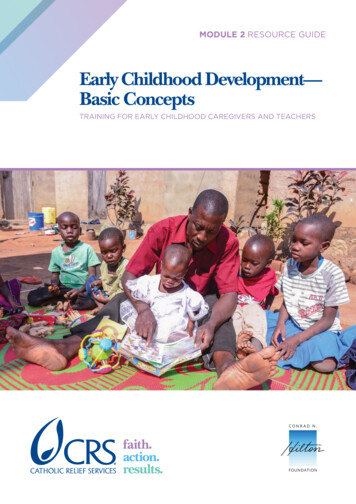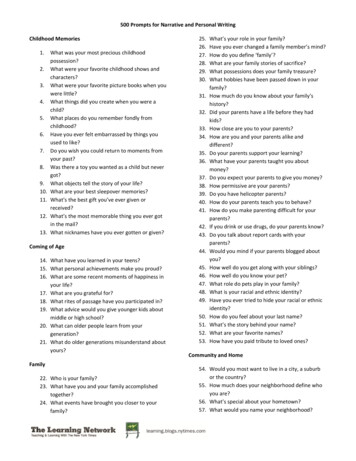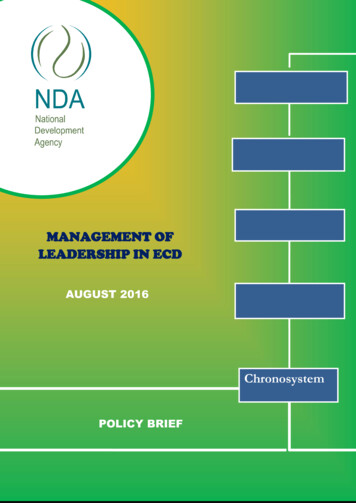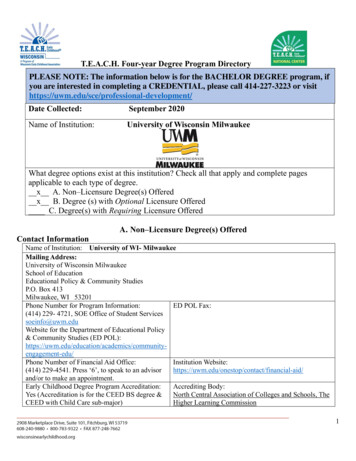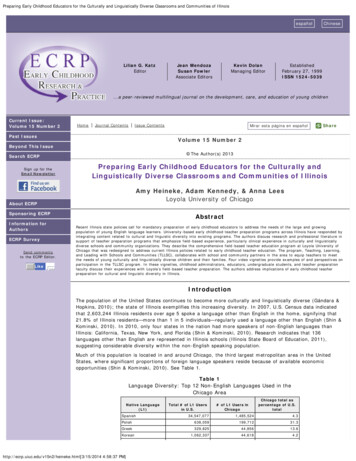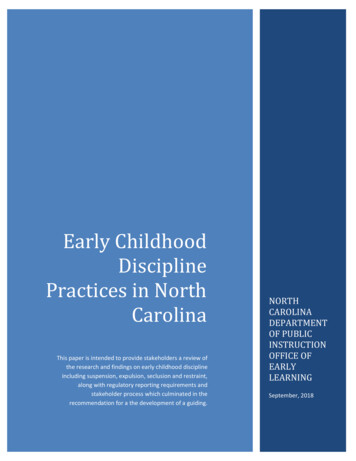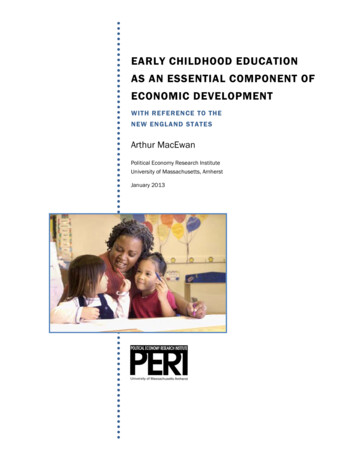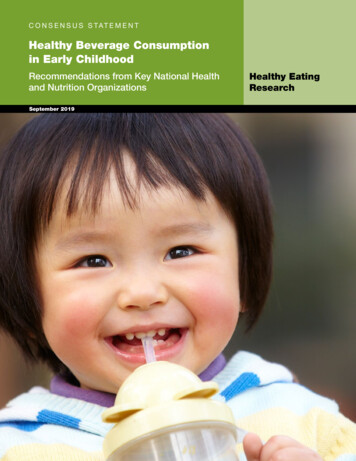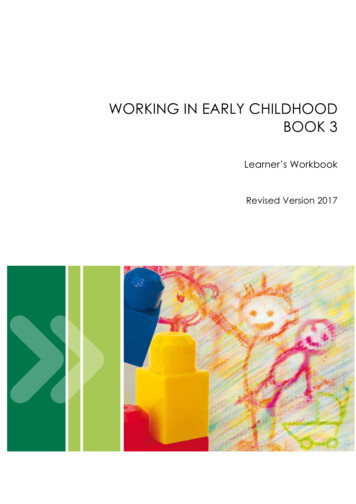
Transcription
WORKING IN EARLY CHILDHOODBOOK 3Learner’s WorkbookRevised Version 2017
2017. This version of the Working in Early Childhood program was prepared by Anne Shinkfield,Shire of Ngaanyatjarraku, Warburton WA, in consultation with Jody Adams, Principal Lecturer,South Metropolitan TAFE, WA.The update of these learning resources has been made possible with funding from theGoldfields-Esperance Development Commission through the Royalties for Regions, CommunityChest Fund.Design and layout updates by robyn@studio32.com.auCover illustration/photography by@stevebrØwneExcluding logos, trade mark-protected material and third-party content this resourceis available under a Creative Commons Attribution 4.0 (CC BY 4.0) license. For more informationsee https://creativecommons.org/licenses/by/4.0/This resource is based on the ‘Working in Early Childhood’ program prepared by Anne Shinkfield,Goldfield’s Education District, Kalgoorlie WA December 2007.Original version of this resource Department of Training and Workforce Development 2016available from ng-and-learning-resources.Used and adapted under Creative Commons Attribution 4.0 (CC BY 4.0) /
Working in Early ChildhoodLearner’s Workbook 3The Working in Early Childhood program is a set of learning materials thatintroduces the foundational knowledge and skills required to work withyoung children and their families in a range of early years settings.Aspects of child development, play and learning, health, safety, nutritionand communication are facilitated through the completion of workplacebased tasks that include the preparation and implementation ofregular play activities for young children.
Working in early childhoodBook3Program OverviewBook 1 Child development Preparing play activities for children Safety at playBook 2 Observation and planning for play activities Food and nutrition, child health and hygiene Child development – language andcommunication developmentBook 3 Babies and infants Inclusive early childhood environmentsand inclusive activities Readiness for kindyBook 4 Stages of play, communicating withchildren Children and families, culture and diversity Putting it all together – programming andworking in early childhood settings3
BookWorking in early childhood3Learner’s Workbook 3Session topic3.1 Babies and infants:Workplace activity3.1 Making MobilesPage7developmental milestonesand responding to cues3.2 Babies’ Toys223.3 Blocks and Construction Play343.4 Making and playing with Goop473.5 Getting ready for kindy3.5 Visit to Kindy623.6 Developing skills for3.6 Cutting, Pasting and Drawing793.7 Counting, Shapes and Colours943.2 Babies and infants:play and learningenvironments3.3 Inclusive early childhoodenvironments3.4 Inclusive early childhoodactivitieskindy3.7 Developing routines foractivities3.8 Play activities for3.8 Play Activities for a Child109Individual Children5
Working in early childhoodBook3Session 3.1Babies and infants:Developmental milestonesand responding to cuesIn this session you’ll learn about: the milestones of physical, social, emotional, cognitive andlanguage / communication development for babies and infants responding to baby’s and infant’s cues activities to encourage young children’s development Principle 1: Secure, respectful and reciprocal relationships Learning outcome 1: Children have a strong sense of identity– children feel safe, secure and supportedYou’ll show you’ve learnt this by: completing Task 3.1 completing Planning Notes 3.1 preparing and carrying out Activity 3.1 – Mobiles completing Workplace Activity Record 3.1 storing any photos from this activity in your evidence fileFoundation skills in the workplace: Making decisions: responding to young children’s cues Writing: Tasks, Planning Notes and Workplace ActivityRecords for sessions 3.1 – 4.83.1 Developmental milestones and responding to cuesEarly Years Learning Framework links:7
Working in early childhoodLearning notes 3.1Development in the first 12 months of a child’s lifeThe physical, social, emotional, cognitive and language developmentthat happens in the first 12 months of a baby’s life is quite amazing!The example below shows a baby’s gross motor skill development3.1 Developmental milestones and responding to cuesduring the first year of life.8At three months, a baby begins to wave his/ her arms andkick his/her legs.Example:At six months, he/ she is beginning to crawl.At nine months, he/she can move about on two feet whileholding onto furniture.At one year of age, he/ she can stand up alone.Book3
Working in early childhoodBook3Comparing the developmental skills of 4 month old babies with 9 monthold babies, it is easy to see how fast children develop during these earlymonths of life across all the domains of development.Four-month-oldNine-month-oldbegins babblingbabbling, now has vowels andconstanants together –‘mama’ and ‘dada’plays with their fingersand fingersturns head to search forrecognises their own name whenany sounds or voicescalledholds objects briefly in their handholds an object in each hand andor handsbangs them togetherbegins listening to anyshows interest in listening tosounds and voicesfalls over if put in thesitting positionmakes a wide range ofsounds and noisessmiles at strangerspeople talk to each othercan sit without supportimitates speech soundsdisplays fear or uneasearound strangers3.1 Developmental milestones and responding to cuesholds objects using their thumbs9
Working in early childhoodResponding to babies and infantsBy getting to know the babies and infants in your early childhood setting,you can respond to them in the best way possible to meet their needs.As a child’s needs are met, they develop trust a belief that they will be cared for a belief that they are valuedThe children will feel ‘safe, secure and supported’. This is foundational to3.1 Developmental milestones and responding to cuestheir well-being and contributes to their positive social and/or emotional10development.Picking up the cuesHow do babies let you know what they need? How do they let you knowthat they are hungry, tired, happy, cold, peaceful, wet, fearful?Babies and infants can’t tell you what they need, but they docommunicate with you and let you know what they need through cues.These cues include crying smiling wriggling making little noises raising their arms moving their mouth staring and making eye contactExample:If a baby is making sucking noises with their mouth theyare probably letting you know that they are hungry.Book3
Working in early childhoodBook3By watching a mother with her baby, you can observe how the motherknows how to meet the baby’s needs in just the right way so that the babyis comforted.From a very early age, a child learns to trust that the parent / caregiverwill always meet their needs at the right time.If you work in an early childhood setting where the parents leave thechildren in your care, it can take some time and patience for you to get tochild calmly and carefully you will soon find that the children will learn totrust you.Early childhood educators in child care centres also need to be aware ofthe family’s child rearing practices. These practices include the waysthat their parents / caregivers respond to the child’s cues in the homeenvironment.Through talking with the parents / caregivers the educator can learn howto meet the young child’s needs in consistent and appropriate ways. Thismeans that the parents can trust that their child’s needs will always bemet while the child is away from their care.3.1 Developmental milestones and responding to cuesknow the cues of each child in your care. However, by responding to each11
Working in early childhoodPlanning activities for babies and infantsPlanning activities for babies and infants uses the same process asplanning activities for older children – observe the child and the things that they can do check the milestone charts for the child’s age to see what skills maybe next3.1 Developmental milestones and responding to cues 12choose activities that provide opportunities for the baby or infant topractice skills or learn new skills while they playAs an extended learning activity for Learner’s Workbooks 3 and4, there will be a ‘Task’ related to the learning notes for everysession.For this session, Task 3.1 will give you practice in selecting playactivities to encourage particular developmental skills for babiesand infantsBook3
Working in early childhoodBook3Task 3.1Selecting play activities for babies and infantsYou can do this task on your own or as a group.1. Read through the milestone lists for babies and infants and note thephysical developmental skills.2. For the physical developmental skills listed below, describe one playactivity that will encourage the development of each skill.Explores their worldwith their hands andmouthLifts head up while ontheir stomachPlay Activity3.1 Developmental milestones and responding to cuesDevelopmental skills13
Working in early childhoodDevelopmental skillsBegins to crawlHolds things with their3.1 Developmental milestones and responding to cuesfinger and thumb14Stands up whileholding on tosomethingExplores things byshaking themReaches for thingsPlay activityBook3
Working in early childhoodBook3Word list swriggleseye contactrespond /respondingchild rearingpracticesstandards ience3.1 Developmental milestones and responding to cueshungry15
Working in early childhoodActivity 3.1 Making mobilesThe activity is to make a mobile to hang in an area ofthe early childhood setting where the babies usuallyare. The baby’s holistic development is encouraged asthey respond to the mobile by looking, moving theirarms, smiling, focusing their gaze and watching itmove.3.1 Developmental milestones and responding to cuesPreparation:16 Negotiate with staff where the mobiles will be set up in theearly childhood setting and if they have particular conditionsto be met about safety, size and placement Read ‘Learning through Play – Mobiles’ Use Planning Notes 3.1 to plan the design, list the materials,organise how and when you will make the mobile and theninstall it in the early childhood settingDoing the activity: Make the mobile and set it up in the early childhood setting Observe the responses of the babies to the mobilesFollow up to the activity: Complete Workplace Activity Record 3.1 Date and name photos of making the mobiles and the babieswatching the mobiles, and store the photos in your evidenceportfolioBook3
Working in ingmobilesAges of children:Children under 12 months of agePhysical development – gross motor skillsEYLF learningoutcomes:children feelsafe, secure andsupported.Social and/or emotional developmentfrom LO 1Domains of development:Cognitive developmentLanguage developmentPhysicalPhysical developmentdevelopment:– fine motor skills: usingtheir fingersfor rolling, cutting and pushing thedeveloping‘eye – andhandhandscoordination’playdough moving their arms to reach towards the mobiles following the mobile with their eyesSocial and/or emotional development: Socialplayingwith emotionalothersand/ordevelopment: sharingthe rollers,shapes andthe playdoughrespondingto the mobile’smovement showing happiness with the mobile’s movementCognitive development:development: Cognitivelanguageskills – talking about what they are doing, listening to othersaboutthewhatthey aredoing talkwatchingmobilemove thinking about what they will do, what the playdough feels like, whatLanguagethey candevelopment:do with it, watching others use the playdoughmakingcommunicative usingtheircreative skillsnoisesby making things with the playdough3.1 Developmental milestones and responding to cuesWhat arelearninglearningwhile theywhileare watchingWhatarebabiesthe childrenthey aremobilesplayingmove?withplaydough?17
Working in early childhoodPlanning notes 3.1Activity title:Date:Time:Location:3.1 Developmental milestones and responding to cuesPreparing for the activity:18 selecting the activity how many children? What are their stages of development? purpose for the activity equipment and materials needed (do you need to try theactivity first?)Book3
Working in early childhoodBook3Planning notes 3.1Doing the activity:1 How will you set up the activity?2 How will you introduce the activity to the children?3 How will you finish the activity with the children?Draw how the activity will be set up:3.1 Developmental milestones and responding to cues4 What do you need to do to clean and pack up the activity area?19
Working in early childhoodWorkplace activity record 3.1Activity title:Date:Time:No. of ChildrenAdultsLocation:3.1 Developmental milestones and responding to cues1 My role in the activity202 Children’s response to the activityWhat did you see the children learning through this activity?Did they enjoy the activity?3 EYLF – Early Years Learning FrameworkHow was the EYLF link demonstrated for this session during theplay activity?Book3
Working in early childhoodBook3Workplace activity record 3.14 Doing the activity:Things that worked well during the activity5 Foundation skills:How did you demonstrate the foundation skills listed for thissession?6 Workplace Evidence:Named and dated photos added to my evidence portfolio for thisactivity3.1 Developmental milestones and responding to cuesThings that I’d change for next time21
Working in early childhoodSession 3.2Babies and infants:Play and learning environmentsIn this session you’ll learn about: play and learning environments for babies and infants setting up interesting environments for babies and infantsEarly Years Learning Framework links: Practice: Learning through play Practice: Learning environments Learning outcome 4: Children are confident and involvedlearners – children develop dispositions for learning, such ascuriosity, cooperation, confidence3.2 Babies and InfantsYou’ll show you’ve learnt this by:22 completing Task 3.2 completing Planning Notes 3.2 preparing and carry out Activity 3.2 – Babies’ Toys completing Workplace Activity Record 3.2 storing any photos from this activity in your evidence portfolioFoundation skills in the workplace: Planning and organising: designing and making up a learningenvironment for babies Reading: the Learning Notes for each session; the Word listsfor each sessionBook3
Working in early childhoodBook3Learning notes 3.2Play and learning environmentsDuring the first twelve months of a child’s life, children not only grow anddevelop physically, but in this time they also learn to sit, crawl, standand even walk. They learn to reach for things, hold things and playgames with objects and they learn to use their hands and fingers for anincreasing number of activities.The environment of your early childhood setting definitely affects thedevelopment of all babies and infants at your setting. The environmentshould create a sense of belonging and feelings of security and comfortso that the little children will feel safe as they explore and try new things.In the home, the baby or infant is part of the family. The environment isthe family home and the baby or infant can feel safe and secure in thelove and care of the family. With the emotional security that comes fromthis care, the baby’s development will progress.The baby or infant’s parent / caregiver will provide comfort to the youngchild even when they go to a new environment, such as play group or ashopping centre, so that even though the physical environment may beIn a child care centre, babies and infants will not be with their parents/ caregivers, so the early childhood educators need to make sure thatthe babies and infants feel comfortable and safe away from their homeenvironment.3.2 Babies and Infantsunfamiliar, the child still feels safe and secure.23
Working in early childhoodTo encourage the development of babies and infants, try to keep thingsin the same place most of the time (like in a home) so that the childrenbecome familiar with the environment. Favourite toys or other items canalso help to make the child feel that they belong there and feel safe andcomfortable in the early childhood setting.Setting up environments for babies and infantsEarly Childhood environments for babies and infants should be: attractive – welcoming and pleasant to both look at and rest in interesting – with interesting things to look at and do familiar – things stay in the same places so the babies / infants feelcomfortable in an environment that they know clean – hygienic tidy and organised – so that it is easy to find things and easy to putthings away safe – each area should allow the baby or infant to move around3.2 Babies and Infantssafely24Example:If the area around the baby is familiar, interesting andsafe then the baby will feel secure and be encouraged tolook at things and to reach out and explore things in theirenvironment.Book3
Working in early childhoodBook3Consider the play and learning environment for the babies in yourplaygroup, crèche or early childhood setting. Is there anything you coulddo to make the environment more interesting, familiar and attractive forbabies?For example: Are there comfortable mats or cushions for them? Much of their timeis spent on the floor – learning to sit, crawl, stand and walk. Is there space for babies / infants to practise crawling, standing,pushing? Is there enough equipment for the babies / infants? Developmentallychildren at this age haven’t learn to share so having two or three ofthe most popular items is very important. Are there interesting things to look at, such as photos, and are theseat the eye height of infants (not high up on walls)? Are there low shelves for storing babies / infants toys so that thechildren can develop their independence and reach to get the toys forthemselves? Are all the toys, equipment and furniture around the baby’senvironment safe for babies to use – no sharp corners to fall on, no3.2 Babies and Infantspieces that can come off in mouths?25
Working in early childhoodTask 3.2Designing a play and learning environment forbabiesDesign and draw an interesting environment for babiesand infants in your early childhood setting.Make sure that the environment is safe, comfortable, interesting3.2 Babies and Infantsand inviting.26Book3
Working in early childhoodBook3Word list ionheightfurnitureweightidentifysecurecomfort /comforted /comfortableemotional ntpopularindependence3.2 Babies and Infantsunfamiliar27
Working in early childhoodActivity 3.2 Babies’ toysFor this activity you will make a toy / activity toencourage the development of the fine and / or grossmotor skills of a child up to 9 months of age.Preparation: Negotiate with staff where and when you will do the activityin the early childhood setting and with which children (andparents) Read ‘Learning through Play – Babies’ Toys’ Observe the baby / babies for whom you are making the toys.What skills do they have? What do they like doing? What skillsare they ready to learn? Use Planning Notes 3.2 to document the design, theequipment you’ll need, when you will do this and how it willwork. Decide if you will leave the toy / activity at the earlychildhood setting for children to use in the futureDoing the activity:3.2 Babies and Infants Set up the learning environment and introduce the new toy tothe baby (and parent if they are there). Give them plenty oftime and encouragment28 Watch how the children show interest and enjoy the activityand how they interact with adults around themFollow up to the activity: Complete Workplace Activity Record 3.2 Date and name photos of the preparation and the childrendoing the activity and store them in your evidence portfolioBook3
Working in y toysAges of children:0 – 12 monthsDomains of development:Physical development: gross and fine motor skillsSocial and/or emotional developmentEYLF learningoutcomes:children developdispositions forlearning, suchas curiosity,cooperation,Cognitive developmentconfidenceLanguage developmentfrom LO 4What are the babies / infants learning while they are playingwith baby toys?Physical development: fine motor skills - using their fingers and hands to touch, move, graspthe toys gross motor skills – reaching for toys, crawling after toys, standing andpushing toysSocial and/or emotional development:responding to those around them feeling safe and secure in their environment developing interetsCognitive development: thinking – working out how to move / use the toys repeating activities – working out how to make things happen againLanguage development: making noises – vocalising, copying sounds, listening to others talking,following instructions / actions3.2 Babies and Infants 29
Working in early childhoodPlanning notes 3.2Activity title:Date:Time:Location:3.2 Babies and InfantsPreparing for the activity:30 selecting the activity how many children? What are their stages of development? purpose for the activity equipment and materials needed (do you need to try theactivity first?)Book3
Working in early childhoodBook3Planning notes 3.2Doing the activity:1 How will you set up the activity?2 How will you introduce the activity to the children?3 How will you finish the activity with the children?4 What do you need to do to clean and pack up the activity area?Draw how the activity will be set up:3.2 Babies and Infants31
Working in early childhoodWorkplace activity record 3.2Activity title:Date:Time:No. of ChildrenAdultsLocation:1 My role in the activity2 Children’s response to the activityWhat did you see the children learning through this activity?3.2 Babies and InfantsDid they enjoy the activity?323 EYLF – Early Years Learning FrameworkHow was the EYLF link demonstrated for this session during theplay activity?Book3
Working in early childhoodBook3Workplace activity record 3.24 Doing the activity:Things that worked well during the activityThings that I’d change for next time5 Foundation skills:How did you demonstrate the foundation skills listed for thissession?Named and dated photos added to my evidence portfolio for thisactivity3.2 Babies and Infants6 Workplace Evidence:33
Working in early childhoodSession 3.3Inclusive Early ChildhoodEnvironmentsIn this session you’ll learn that: early childhood environments should be inclusive of allchildren learning about the particular needs of some children enableseducators to provide excellent play and learning environmentsthat encourage each child’s development3.3 Inclusive early childhood environmentsEarly Years Learning Framework links:34 Principle 2 – Partnerships Principle 3 – High expectations and equity Learning outcome 1: Children have a strong sense of identity –children develop knowledgeable and confident self-identitiesYou’ll show you’ve learnt this by: completing Task 3.3 completing Planning Notes 3.3 preparing and carrying out Activity 3.3 – Blocks andConstructions completing the Workplace Activity Record 3.3 storing any photos from this activity in your evidence portfolioFoundation skills in the workplace: Learning: about the additional needs of childrenBook3
Working in early childhoodBook3Learning notes 3.3Inclusive early childhood environmentsThe Early Years Learning Framework explains why early childhoodeducators must consider the needs of all children when planning earlychildhood play environments and activities.“Inclusion involves taking into account all children’s social, culturaland linguistic diversity (including learning styles, abilities, disabilities,gender, family circumstances and geographic location).The intent is to ensure that all children’s experiences are recognisedand valued. The intent is also to ensure that all children havedemonstrate their learning and to value difference”.(Australian Government Department of Education, Employment andWorkplace Relations, (2009) BELONGING, BEING & BECOMINGThe Early Years Learning Framework for Australia p.45)All children learn new skills as they grow and get older. However, there isquite a lot of difference in the rate at which children learn these skills asthey move through the stages of development.Example:Some children are quick to learn how to walk, walkingbefore they are 1 year of age. Other children take muchlonger to learn how to walk, maybe not until they are2 years of age.3.3 Inclusive early childhood environmentsequitable access to resources and participation, and opportunities to35
Working in early childhoodBook3Children with additional needsSome children also have additional needs that may affect their development.A child’s additional needs may be due to: medical conditions – eg down syndrome, cerebral palsy impairment – visual impairment, hearing impairment speech difficulties, physical disabilities learning disabilities developmental delay autism behavioural difficultiesAt playgroups, children are usually with one of their parents / family members,and so the parent would assist the child with any particular needs that occur3.3 Inclusive early childhood environmentsduring the program. But at a crèche or child care centre, the child is without36the family and the educators need to know how to care for the child and how toassist with their additional needs.If there are children with additional needs at your early childhood setting, theearly childhood educator will need to talk with the child’s family to learn aboutthe child and any particular support that the child will need. The family could tellyou about: their child’s particular needstheir child’s likes and dislikesthe assistance that their child will need in particular activitiesthe best way to communicate with their childthe best ways to support and encourage the child’s developmentWith this knowledge, excellent and appropriate activities can be providedto encourage the development of the child in the context of the inclusiveenvironment of the early childhood program.
Working in early childhoodBook3All children learn through playAs we have discussed throughout the ‘Working in Early Childhood’program, all children, including children with additional needs, learnthrough play.For all children, play and learning activities are selected by observing: what the children can do what they like what they are interested in what skills they are demonstratingWhen selecting activities and creating learning environments for childrenwith additional needs, the same observations are required, so that theactivities will be interesting and challenging and encourage the children topractice their skills while they are playing. have to repeat activities much more often to learn a skill need to learn a set of skills that others don’t have to learn require special equipment to assist them to learn a skillThrough these observations and the information provided by the child’sfamily, the educator can ensure that the inclusive early childhoodenvironment will continually provide play activities that will always beinteresting and encourage the learning and development of all children.3.3 Inclusive early childhood environmentsHowever, you might notice that a child with additional needs may –37
Working in early childhoodTask 3.3 About an additional needFor Task 3.3, find out about an additional need that you areinterested in and present the information that you find out to yourgroup.You may choose to find out: what is the cause of the additional need? how does the additional need affect the child’s development? how can the child’s development best be supported /encouraged? what specific equipment, routines or activities will assist thechild? what changes would need to be made to make an inclusive3.3 Inclusive early childhood environmentsearly childhood environment to include this child?38 what play activities could be prepared to encourage the child’sdevelopment?Book3
Working in early childhoodBook3Word list 3.3WordMeaninginclusiveadditional equalitydiversityspecific3.3 Inclusive early childhood environmentsspecific39
Working in early childhoodActivity 3.3 Blocks and ConstructionAfter observing children playing with blocks andconstruction materials, introduce one new activity toencourage their ‘block and construction play’.Preparation: Negotiate with staff where and when you will do the activityand with which children (and parents) Read ‘Learning through Play – Block and Construction Play’ After observing the children at play, plan one new activity toextend their ‘block and construction play’3.3 Inclusive early childhood environments Make sure that the activities and the environment are inclusiveof all children at the early childhood setting40 Use Planning Notes 3.3 to plan the activities, list therequirements and note any particular changes to meetchildren’s additional needsDoing the activity: Set up the block and construction play environment Introduce the new activity to the children. Watch how the children show interest and enjoy the activity. Ifthis is a group activity, observe how the children interact witheach otherFollow up to the activity: Pack away and clean up the activity area Complete Workplace Activity Record 3.3 Date and name photos of the preparation and the childrendoing the activity and store them in your evidence portfolioBook3
Working in cks and ConstructionPlayAges of children:Any age, as long as an adult watches over the0 – 1 year oldsEYLF learningoutcomes:children developDomains of development:Physic
Book Working in early childhood 3 Development in the first 12 months of a child's life Learning notes 3.1 The physical, social, emotional, cognitive and language development that happens in the first 12 months of a baby's life is quite amazing! The example below shows a baby's gross motor skill development during the first year of life.

